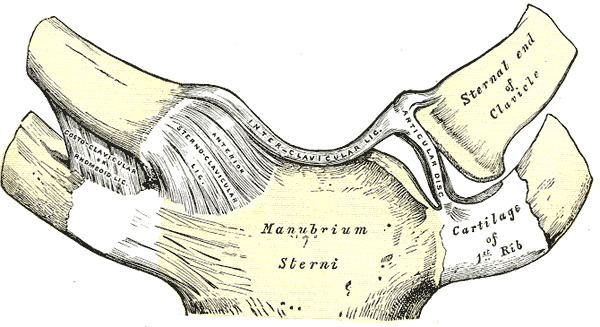MeSH A02.835.583.781 TA A03.5.04.001 | Dorlands/Elsevier a_64/12161562 FMA 25883 | |
 | ||
Latin articulatio sternoclavicularis | ||
The sternoclavicular joint or sternoclavicular articulation is the joint between the manubrium of the sternum and the clavicle bone. It is structurally classed as a synovial saddle joint and functionally classed as a diarthrosis and biaxial joint. It is composed of two portions separated by an articular disc of fibrocartilage. The bone areas entering into its formation are the sternal end of the clavicle, the upper and lateral part of the sternum, (the clavicular notch), and the cartilage of the first rib, visible from the outside as the suprasternal notch. The articular surface of the clavicle is much larger than that of the sternum, and is invested with a layer of cartilage, which is considerably thicker than that on the sternum.
Contents
The costoclavicular ligament is the main limitation to movement, and therefore the main stabilizer of the joint. A fibrocartilaginous disc present at the joint increases the range of movement. Sternoclavicular dislocation is rare, but may result from direct trauma to the clavicle or indirect forces applied to the shoulder. Posterior dislocations deserve special attention, as they have the potential to be life-threatening because of the risk of damage to vital structures in the mediastinum.
Structure
Function
The sternoclavicular joint allows movement of the clavicle in three planes, predominantly in the anteroposterior & vertical planes, although some rotation also occurs. A description of movement would be elevation and depression. Muscles don't directly act on this joint, although almost all actions of the shoulder girdle or the scapula will cause some motion at this articulation.
The unique double-hinged articular disk found at the junction of the clavicular head and manubrium allows for movement between the clavicle and the disk during elevation and depression of the scapula. This disk also allows motion between the sternum (manubrium) and itself during protraction and retraction of the scapula.
Clinical significance
Trauma may result in sternoclavicular joint dislocation. Posterior dislocation puts the mediastinal structures at risk. Spontaneous subluxation also occurs sometimes. In SAPHO syndrome there may be arthropathy of the sternoclavicular joint. Septic arthritis may rarely affect the sternoclavicular joint.
